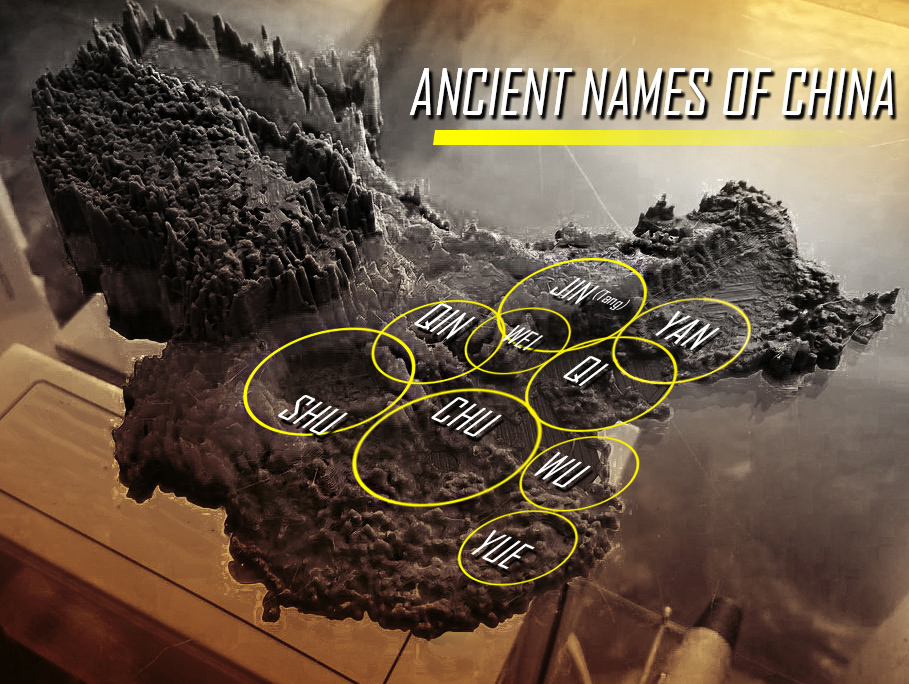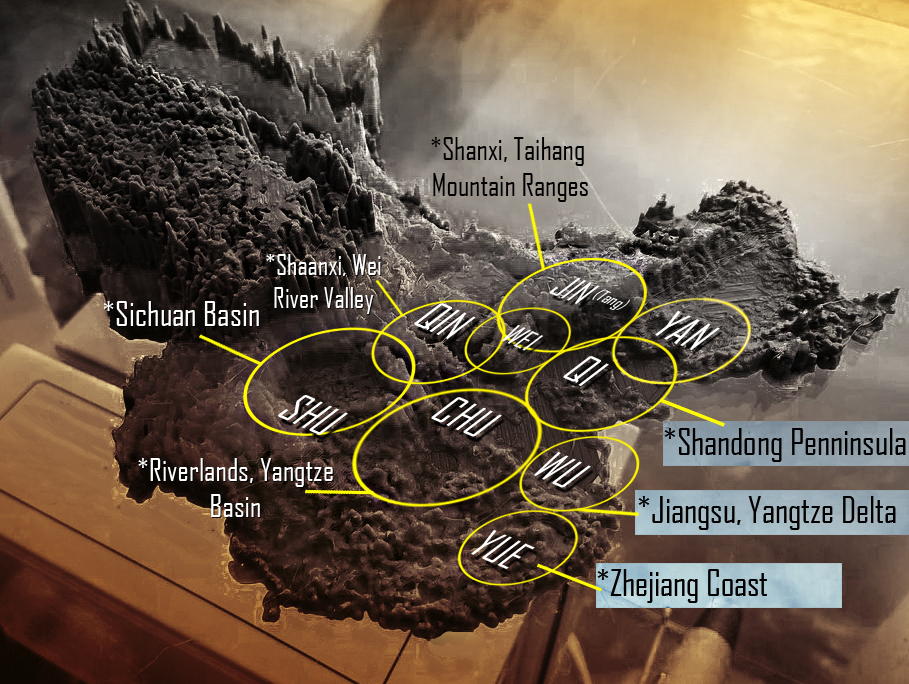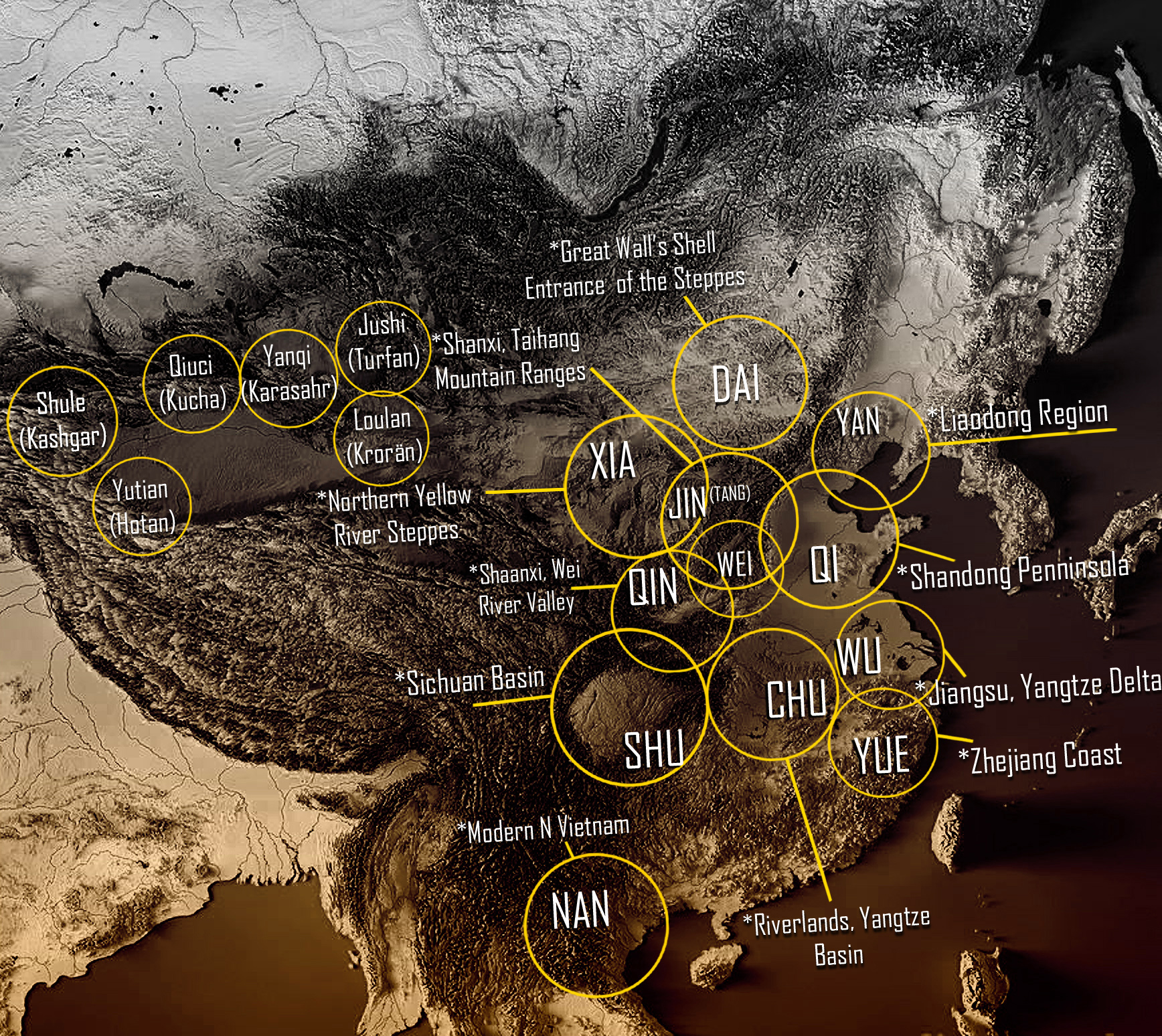Naming Conventions of Ancient Chinese Kingdoms: 古国号
Music: Unifying the Tribes (TW3K)
Art by Forky Xu
As a fan of Chinese history, have you ever noticed certain patterns as to the names of many Chinese polities? It does not take intense scrutiny to notice that there's many repeated kingdoms in China named Wu 吴, that all happen to be the in same geographical area across many different eras. Kingdoms that repeatedly sprouted from the northern part of Central China that's called Wei, or kingdoms that's located in the Sichuan Basin that's often called Shu 蜀, or fiefs in northeastern China that's called Yan 燕?
KINGDOM NAMES
Many of the future dynasties will resurrect the names of the Spring & Autumn and Warring States Kingdoms that existed in the region from where they launched their rebellion. During the fall of the Han dynasty, the warlords who then owned the respective of Sichuan Basin, Yangtze Delta, and Wei River Basin resurrected the names of Shu, Wu, and Wei. During the late Sui dynasty, the Duke of Tang- who was enoffed the region of Tang (the old name of Jin) in the Taihang Mountains in what is today's Datong rose in rebellion from this headquarters and declared the Tang dynasty.
The answer, as some of you have guessed, is simple. These are the names of kingdoms that once existed in these areas- especially from the times of the Spring and Autumn period and the Warring States period. If there was a state that say controlled a certain region for many centuries, the whole region- even after the kingdom was vanquished was still unofficially named after them. Eventually the Qin dynasty conquered them all, but even after their destruction, these ancient names still remained as a shorthand for the whole region. During the early Han dynasty, many of the imperial Princes (Uncles) would governor many eastern region of the empire as their own semi- autonomous kingdoms. Many of these kingdoms still bore the ancient names of the region such as Qi, Yan Chu, and Wu etc.
Topographical map of China with the regional names- and their corresponding geographical regions marked. Each region had its own cultural and regional characteristics, and although the imperial government might assign different commanderies to oversee the region, unofficially those regions were still referred to as Chu, Qi, Yan etc.
The level of regional autonomy would drastically increase during the collapse of the Han dynasty, where imperial power diminished and all of the Han regional warlords held sway of their own fiefs and provinces as virtual independent kingdoms (and during the 3 Kingdoms period, totally independent kingdoms.) For the next millennium, the vast majority of freshly created kingdoms and dynasties would owe their state's name/ and that of their dynasties to the fiefs where its founder's clan hails from- or directly controlled.
Triumphal Return: Art by Nuit Blanche
REGIONAL NAMES
Even when the Chinese states reforged into a large contiguous empire, - these regions are still called by their ancient names in fiefs and administration terms. For instance, when the Tang imperial Prince Li Shimin was appointed the governor of Western China, around the ancient Wei River Valley region- the old heartland of the ancient kingdom of Qin, he was ennobled as the "Prince of Qin" and it was what he went by before his ascension as the new Tang Emperor. Same goes for another ambitious warrior prince who was once a military governor turned- emperor. The Ming Prince Zhu Di, the eventual Yongle Emperor. Before his military bid to usurp the imperial throne, he was in charge of the northern military frontier at Yan of northeastern China. Eventually, that Prince of Yan would ascend the throne as the Ming Emperor and his own regional capital would become the imperial capital of Beijing.
Music: Eternal Empire (Drums)
REGIONAL NAMES IN ANCIENT CHINA
Enlarged version of China's ancient borders beyond the Yellow River Basin. "Nan" literally translated as the south is a common name that referred to the area of northern Vietnam. The region of "Xia" describes the northern bend of the Yellow River that flows into the northern steppes.
According to ancient Chinese traditions, when the Xia dynasty was toppled its royal family fled north beyond their traditional lands beside the Yellow River and intermarried with the steppe nomads, thereby siring both the Chinese Han race and also establishing a blood relationship with the steppe. Many Xiongnu polities inside China would tried to resurrect an ancestral "Xia" state- because they claimed lineage from the Xia Kings.
Regional names in ancient China, Tarim Basin oasis kingdoms included. The Tarim states functioned as oasis city-state kingdoms. They submitted to the Han dynasty during Emperor Wu's expeditions.
By the Yuan dynasty though, a shift would happen in the naming convention of imperial polities. To consecrate his new dynasty, Kublai Khan named his dynasty Yuan- according to the Daoist concept that Yuan 元 (meaning the primal origin of the universe) is a powerful name. With the setting of this precedence, the names of the future dynasties became abstract. The following Ming 明 dynasty meant the bright dynasty. The Qing 清- or "Pure" dynasty that followed Ming used this abstract convention as well.
Thank you to my Patrons who has contributed $10 and above: You made this happen!
➢ ☯ Muramasa
➢ ☯ MK Celahir
➢ ☯ Thomas Vieira
➢ ☯ Kevin
➢ ☯ Vincent Ho (FerrumFlos1st)
➢ ☯ BurenErdene Altankhuyag
➢ ☯ Stephen D Rynerson
➢ ☯ Michael Lam
➢ ☯ Peter Hellman
➢ ☯ SunB






















Comments
A few points:
1. I am surprised that those Chinese regions remembered their connections to the ancient regional kingdoms of the Spring and Autumn and Warring States. I would have thought after the long Han Dynasty and Tang Dynasty, those regional identities would have been weakened if not forgotten. Especially the Han which lasted 400 years after the end of the Warring States, the fact that the Three Kingdoms took their names from Wei, Shu and Wu is amazing. But I guess it would have been the equivalent of France or Spain today, despite these being Nation States for centuries the regional identities are stills strong, with Catalonia wanting independence from Spain.
2. The Hun claim to Xia ancestry, how serious was this? There is no more prestigious a dynasty as the first Chinese dynasty of Xia, descendants of Yu the Great himself!! The Huns married into the Han dynasty as well, also claiming Han descent from the He Qin marriage arrangements. I wonder if their western counterparts, the Huns of Atilla remembered their claims to Xia ancestry, do Hungarians who love to claim Hun descent, know that they have Xia roots?
3. Chinese warlords recycling ancient state names may not be a surprise, but what about the Barbarians? You mentioned the Huns and Xia but what about the Toba, Shatuo Turks, Xianbei, Murong, why did they choose Chinese state names? why were the Toba so proud of Wei, why were the Murong so into Yan I wonder?? Why did the Khitan choose 'Liao' ??
4. I've always wondered by the founders of the Song dynasty chose 'Song' and not use their family name of Zhao? Song was the state of the Shang kings who were allowed to keep the sacrifices going for their Shang ancestors, Confucius was a scion of the Shang house. I wonder why the founders of the Song dynasty chose this state's name when they could have used Zhao their clan name which is of course the name of the State of Zhao from the Warring States Period. It seems arbitrary to me.
5. The Ming and Zhu Yuanzhang's choice of dynastic name has always perplexed me. Why follow Mongol Yuan precedent and choose an abstract name and not follow Chinese precedent? The Mongols were not from historic China so its understandable they would choose Yuan, but the Ming founder was also the Duke of Wu, he should have followed precedent and name is regime the Wu Dynasty, a great name indeed from the Spring and Autumn Period. Why 'Ming' ? did the Confucian ministers object to Ming? Well at least his sons and their titles were taken from Chinese state names as you mentioned, his crown prince was the Prince of Jin and Zhu Di was Prince of Yan, along with their brother the Prince of Zhao held northern military commands and armies to repel the Mongols in the North.
As to the more specific questions: 2. The Hun claim is mostly that- a claim, largely sourced from Sima Qian's accounts, however there are traditions that predates Sima Qian that does not believe this and labels the Xiongnu simply as outsiders. Sima Qian- multiple times tried to associate foreign peoples and contextualize them according to some traditions where a named Chinese ancestral figure wandered off into a region, as descendants of such figures. These should be taken with a good pinch of salt. He labeled the Dian people as descendants of a Chu military expedition (which is nonsense since the locals did not even have Chu material culture) - if fact it almost reminds me of when Europeans found the Great Zimbabwe and thought that blacks could possibly not have built it and it must have been built by some greater wise White cultural enkindlers like the Queen of Sheba. As lovers of history one has to be a bit conservative (as in sticking to hard dry facts) toward these things. I will say that the Xiongnus themselves really capitalized on this claim and several times tried to exert their power as a "Xia" state in the 16 Kingdoms era.
and Guess what, they learned it from the best. Remember, the kingmakers and hegemons of the 16 Kingdoms were nomadic people who fought with and fought alongside the figures from the Three Kingdoms era. They Learned from the 3 Kingdoms statesmen and saw how they were able to make their local provinces into consecrated kingdoms. Even after Jin reunited the realm such a memory is still fresh on their minds since it was only some 30 years ago. So its little wonder how by the break out of the 16 kingdoms period they all know what to leverage these channels to form their own states and blackmail Jin for recognition of their autonomy.
My own very detailed narrative of the 16 Kingdoms here.
https://dragonsarmory.blogspot.com/2020/10/chaos-of-sixteen-kingdoms.html
https://dragonsarmory.blogspot.com/2020/12/chaos-of-sixteen-kingdoms-part-2-anarchy.html
Gansu~Liang·凉
Hebei~Zhao·赵
When the Mongols adopted Yuan, a tradition ended and I think something was lost with the future 'Ming' and 'Qing'. Personally I prefer the old style territorial Chinese dynastic names. Yuan, Ming and Qing seem rootless to me, more ideological than rooted in the land of China and Chinese civilization. Which do you prefer?
Simply put, both are fine for me. It is what it is, and was what it was. Though I find the abstractions more interesting, mainly in that there is a customizeable feel to it in really making it feel unique. I mean after the 5th and 999th Wu that's sited at Jiangsu region etc it became very predictable. Where as ones that are more abstract you get more of a sense of the cultural ethos and the ideals which they revolve their entire dynasty toward.
As someone who really love to RP and create fantasy settings, the latter is more interesting because each dynasty is truly unique regardless of their geographical circumstances.